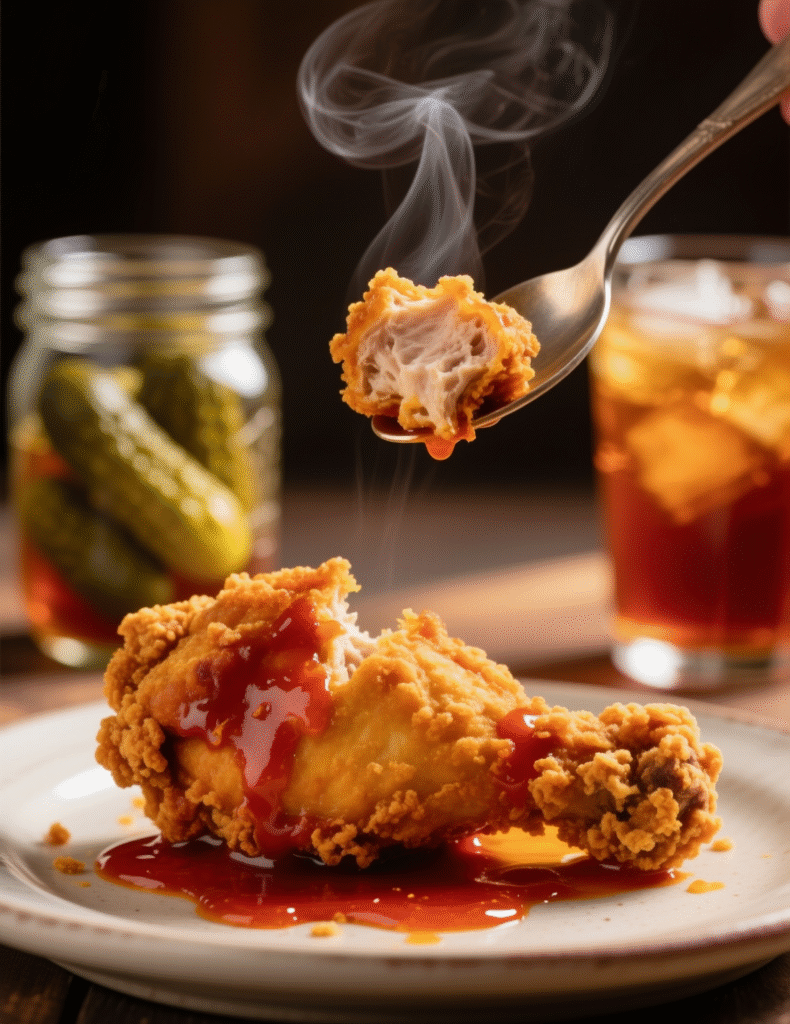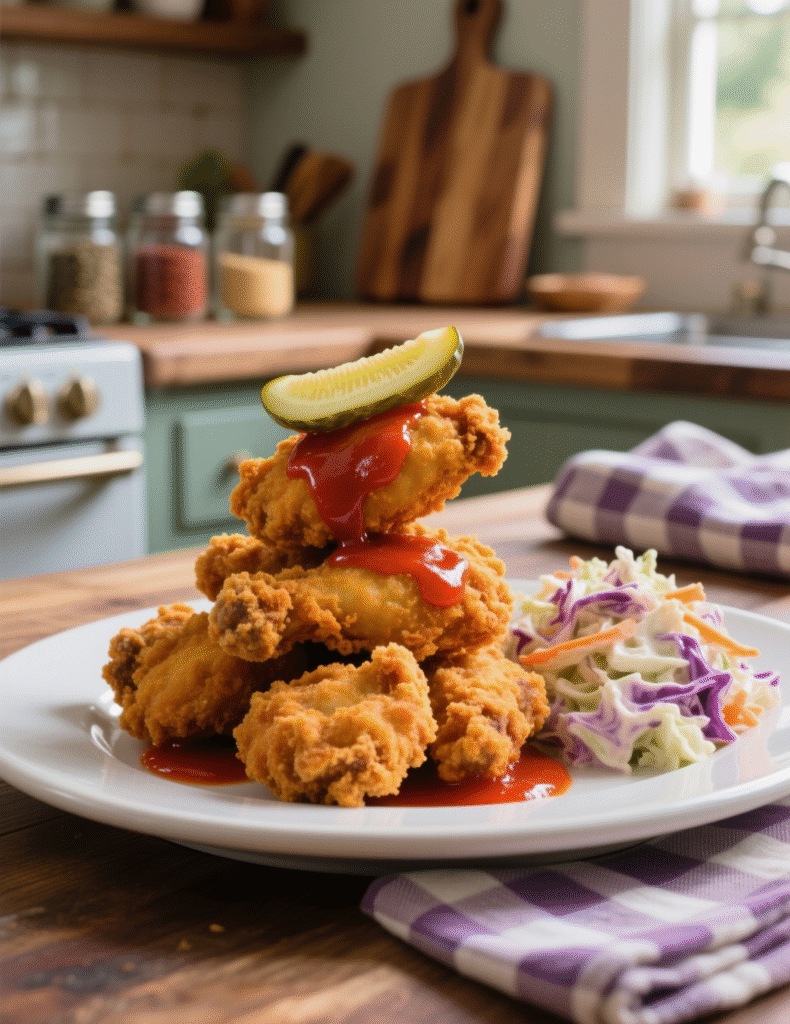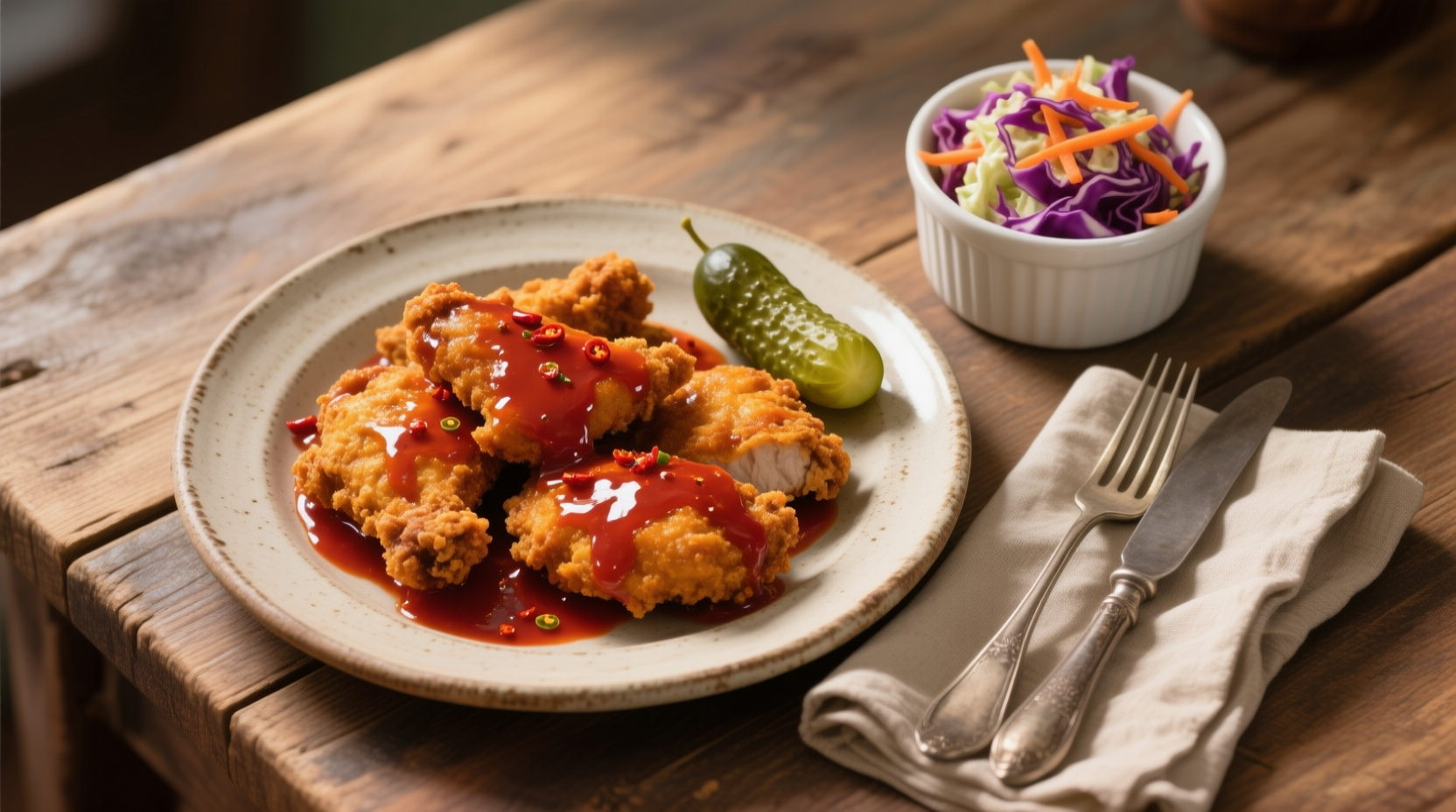You know that dish that makes people cry, sweat, and smile all at once? Nashville hot chicken is that chaos on a plate. But here’s the kicker—we’re doing it vegan. And we’re not just doing some limp cauliflower tossed in oil and calling it a day. We’re going full-on crisp science, oil-temperatures-on-a-thermometer, coating-flake perfection. Because a proper vegan Nashville hot chicken has to do two things: fool the eyes and crush the tastebuds.
The reason pros love this dish is simple—it’s a balancing act. Texture vs. spice. Crunch vs. tender. And with the right plant-based swaps, it can even outdo the poultry version.
Understanding Nashville Hot Chicken Before Going Vegan
Nashville hot chicken started in Tennessee, and the story is wild—legend says it began as revenge. A man’s partner allegedly tried to punish him with an extra-spicy fried chicken. Instead of being mad, he loved it so much that he shared it with the world. That’s how culinary accidents become cultural legends.
The key here isn’t just the spice. It’s the way the oil carries that spice and coats every craggy bit of crispy batter. That oil infusion is everything. Miss that step, and you’re just making spicy fried food.
When we go vegan, we’re not just replacing chicken. We’re re-engineering texture. That means choosing a base—seitan for chew, oyster mushrooms for stringy bite, or firm tofu for a clean protein slab. Each has its quirks.
The Protein Choice: Not All Vegan “Chicken” Is Created Equal
For that Nashville chew, I’ll tell you—seitan is king. It has that dense, shreddable muscle-like bite. But oyster mushrooms? Oh, they fry up with this pulled-chicken vibe that makes you double-take. Tofu? Great for precision control, but you’ve gotta press it dry as desert sand before breading.
Chefs who skip this moisture removal wonder why their batter slides right off. Simple science—water turns your frying oil into a splatter zone and breaks adhesion.
In a professional kitchen, we’ll sometimes double-cook the base. Steam the seitan, chill it, then bread. Or roast mushrooms lightly before frying so their structure stays firm. That’s the behind-the-scenes trick most home cooks never hear about.
The Batter and Breading Science
Now, the coating. Nashville hot chicken isn’t about some sad dusting of flour. It’s about a jagged, rugged crust that locks in moisture. We achieve that by using a wet batter that clings like it’s got bills to pay.
A professional ratio? Equal parts all-purpose flour and cornstarch for that glassy crunch. Add smoked paprika, garlic powder, onion powder, a pinch of cayenne (not too much yet), and fine salt.
Then comes the wet dip. Plant milk with a splash of apple cider vinegar to mimic buttermilk. Let your protein sit in that for at least 20 minutes—this step hydrates the surface, giving you that battered boulder texture when fried.
Pro tip? Double dredging. Wet → dry → wet → dry. Each layer builds more chaos in the crust. And chaos equals crunch.

Frying: Where Professionals Make or Break It
If you’re frying at anything less than 350°F (175°C), you’re sabotaging yourself. Too low, and the crust soaks oil. Too high, and you burn the spice before the interior’s ready.
The trick in a restaurant is to work in batches. Drop your vegan pieces in without overcrowding, because overcrowding drops the oil temperature like a stone in water. And yes, use a thermometer—guessing is for gamblers, not chefs.
We also let pieces rest on a wire rack, not paper towels. Paper towels steam the crust from underneath. A rack keeps air circulating so the underside stays loud when bitten.
The Fiery Oil Infusion
This is the heart of Nashville hot chicken. You take a ladle of that frying oil, still screaming hot, and whisk it with cayenne, brown sugar, smoked paprika, garlic powder, and a little salt. That sugar? Not traditional, but it rounds the heat so it punches without lingering like a grudge.
Pour that over the crispy vegan pieces right before serving. The spice blooms in the hot oil, releasing those deep chili aromatics. This step alone is why the dish slaps different.
Common Mistakes and How to Dodge Them
Mistake one—thinking you can air-fry your way to the same result. Look, I love an air fryer, but for Nashville-style, you want that aggressive oil interaction. That’s flavor chemistry.
Mistake two—overloading on cayenne. It’s tempting to make it lava-level hot, but pros know it’s about flavor layering, not macho heat. That’s why we add paprika for depth, a touch of chili powder for complexity, and sometimes a hint of Korean gochugaru for its mild smokiness.
Mistake three—forgetting the pickle and bread. This dish isn’t complete without thick white bread to catch the spice-oil runoff and dill pickles to cut through the richness. That contrast is non-negotiable.
Trends in Vegan Nashville Hot Chicken
Restaurants are pushing boundaries—some are using chickpea flour for gluten-free crusts, others are smoking the mushrooms before frying for a barbecue twist. We’re even seeing hot-maple drizzles in high-end brunch spots, giving a sweet-scorch fusion.
A 2024 survey by Plant Based Foods Association found that spicy vegan fried chicken sales jumped 32% in the last year. Nashville-style leads the pack. This isn’t just a fad—it’s a menu fixture now.
And on TikTok, crispy vegan hot chicken has become a visual trend. The jagged crust glistening with chili oil plays right into food-porn culture. Chefs who get the plating right—big pickles, bold color—see it go viral.

A Professional Recipe Breakdown
Ingredients (Serves 4)
- 1 lb oyster mushrooms or seitan strips
- 1 cup all-purpose flour
- 1 cup cornstarch
- 1 tbsp smoked paprika
- 1 tbsp garlic powder
- 1 tbsp onion powder
- 1 tsp cayenne (plus more for oil infusion)
- 2 tsp salt
- 1 cup unsweetened plant milk
- 1 tbsp apple cider vinegar
- Neutral oil for frying
Spicy Oil
- 1/2 cup frying oil
- 2–3 tbsp cayenne (adjust to heat preference)
- 1 tsp smoked paprika
- 1 tsp garlic powder
- 1 tbsp brown sugar
- 1/2 tsp salt
Method
- Mix plant milk and vinegar. Let stand 5 minutes to curdle.
- In another bowl, combine flour, cornstarch, paprika, garlic powder, onion powder, cayenne, and salt.
- Dip mushrooms/seitan in wet mixture, dredge in dry mix, repeat once more.
- Heat oil to 350°F. Fry in small batches 4–6 minutes until golden and crisp. Rest on wire rack.
- For spicy oil, combine spices in a heat-proof bowl. Ladle in hot frying oil and whisk until smooth.
- Brush or pour oil over fried pieces. Serve with thick white bread and dill pickles.
Serving Like a Pro
Professionals will plate this on a slab of bread with a deliberate spill of oil pooling underneath. It’s not messy—it’s intentional. The bread acts as an edible sponge, soaking flavor without losing texture.
For color pop, add thin red onion slices or slaw. Not traditional, but it cuts the richness and makes it camera-ready.
Pair it with a cool, creamy vegan ranch to tame the fire for guests who think they’re braver than they are.
Why This Dish Works So Well in a Vegan Format
Animal protein relies on muscle fibers for texture, but in vegan versions, you get to choose your texture. Mushrooms for pull, seitan for chew, tofu for soft bite. That’s flexibility traditional chicken doesn’t give you.
And the spice oil doesn’t discriminate—it clings to any surface with equal obsession. That’s why when done right, most people can’t tell they’re eating vegan.
This recipe proves that technique, not the protein source, defines the dish. Once you’ve mastered the crust, oil, and spice bloom, the sky’s the limit.
Closing Thoughts
Vegan Nashville hot chicken isn’t just a novelty. It’s a chef’s playground. It challenges you to think about protein texture, batter adhesion, oil chemistry, and spice balance all in one go.
The secret isn’t in one magic ingredient—it’s in the layering. Season the flour. Season the oil. Control the heat. Respect the bread-and-pickle tradition.
Do that, and you’re not just making food. You’re making a dish with history, technique, and enough fire to make someone both love you and curse you in the same bite.
FAQs
What is vegan Nashville hot chicken made of?
It’s usually made from seitan, oyster mushrooms, or tofu, coated in seasoned batter, fried, and topped with spicy chili oil.
Can I make vegan Nashville hot chicken gluten-free?
Yes, use chickpea flour or gluten-free all-purpose flour in the batter.
What makes Nashville hot chicken different from regular fried chicken?
The signature step is coating it in spiced hot oil after frying.
Can I bake instead of frying?
You can, but you won’t get the same shattering crunch as deep frying.
How spicy is vegan Nashville hot chicken?
It’s typically very spicy, but you can adjust the cayenne to your taste.
What’s the best oil for frying?
Neutral oils like canola, peanut, or sunflower work best for flavor and smoke point.
Why serve it with bread and pickles?
They balance the heat and soak up the flavorful oil.
Can I air fry vegan Nashville hot chicken?
Yes, but it won’t have the exact same texture as traditional deep frying.
How long does it stay crispy?
It’s best eaten fresh, but can stay crisp for up to an hour if kept on a wire rack.
What sides go well with vegan Nashville hot chicken?
Coleslaw, fries, vegan mac and cheese, or potato salad pair perfectly.

Mariana is a passionate home cook who creates delicious, easy-to-follow recipes for busy people. From energizing breakfasts to satisfying dinners and indulgent desserts, her dishes are designed to fuel both your body and hustle.
When she’s not in the kitchen, she’s exploring new flavors and dreaming up her next recipe to share with the Foodie Hustle community.

